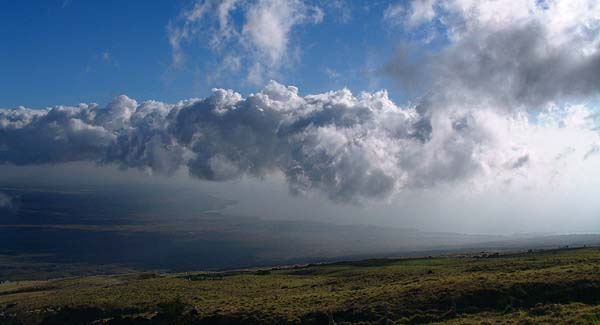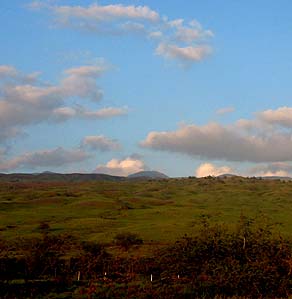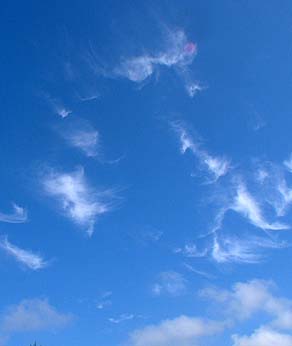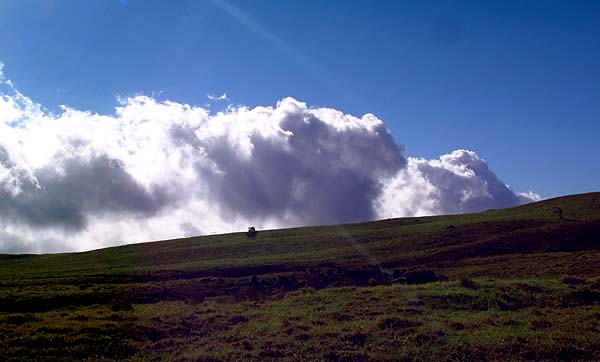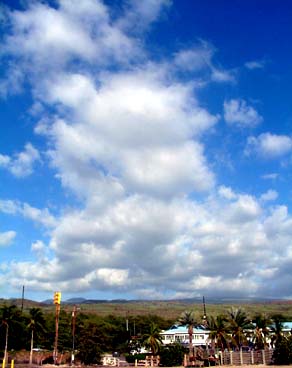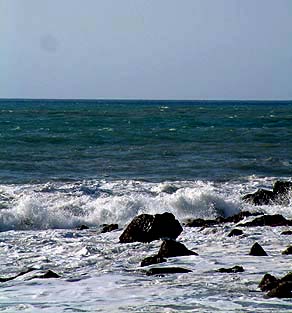 |
 |
 |
|||||
|
|
|||||||
|
|
|||||||
| |
|
|
|
|
“Usually in the morning, wind comes from the East,” Papa says. “Then at a certain time, around noon, it turns around and comes from the West. So these two winds, they just circle in like this. The air current on top there, that’s what creates that. Just like what you get in the ocean there: “When the ocean current goes to south, it hits the bank at Keahole. And it kicks out both ways: going out, going in. So usually it kicks inwards. That’s why the Kawaihae current comes from the south going north. But when it goes up north, it hits the north current, then it rolls back down. So Kawaihae has a whirly current. And they say that as the current rolls around, you have a dead spot in the middle here."
|
||
|
|
||
“So you don’t see clouds hanging over Kawaihae day after day. There’s no clouds. You see the clouds hanging over to the North and South. But in here, it’s always clear. Because with the current, you get that whirl above, and it just kicks out everything. I heard that, then I didn’t pay attention. "But then when I watched the ship come in the harbor, when they docked the ship, you watch the smoke coming out of the ship. It goes up and it just disappears. It just clears out, so you know that some kind of force is there, taking away and pulling them up. So they say it just goes up and whirls around and gets out.”
|
|
|
“I remember every evening we would sit on our porch,” ‘Ilima says. “We would have to light mosquito punk because we had no screens and I remember my Mom would gather all the kiawe beans and whatever kiawe leaves fell. Every evening we would do this, and we would make a fire. The kiawe bean was slow burning, so it kind of got rid of the mosquitoes. "But we’d sit on our porch every evening. And there was this ocean breeze that would come in. You could count on it. You could sit on your porch and just be cool because of this breeze. And then in the morning it would kind of disappear, and there would be very little breeze. “Now you have this stifling kind of wind down at Kawaihae. It’s just not refreshing at all. I don’t know, it’s been ever since they built the coral flats and all that harbor expansion."
|
| |
|
|
Mel adds, “When the wind comes from Waipio, it comes over the hill to Kawaihae, picks up momentum and then it becomes very windy. It’s an unforgettable wind and everything in its path will be tossed aside."
|
||
|
|
||
“It still comes,” ‘Ilima points out. “It happened not frequently. Maybe two or three times a year. And I mean, sand would get into everything. You would have sand in your food. Sand in your beds. But those days, you would have sand because that was all there was. Now it’s dust, because of the construction, and they did away with a lot of the sand.” “The wind from the mountains, that was terrible!” Lani recalls. “It would knock all the coconuts down. It was really strong. It happened all the time. But mostly during the winter months. We hated it. We liked the ocean wind better.” “During winter months, you get that kind of wind,” Papa adds, referring to the Mumuku. “But no more wind like that.”
|
|
|
“Apa‘apa‘a is the most famous wind in Kohala,” Sam explains. “It’s said to be a very strong wind. So it would be a tradewind type of wind that sweeps over the top of the mountain and down the slope. It’s hard to say whether or not it would be a windward-side wind only, and that it applied to the Waipi‘o side. If that’s the case, folks talking about Kawaihae and the leeward side might not mention it at all. “The Naulu is a convection wind, with the heated air moving up the slope. The word ulu, which can be ‘to grow,’ might just as easily apply to the fact that when you look at convectional clouds forming, they seem to grow out of the sea or ground into the sky, upward like a plant. But it’s hard to say what the ulu there refers to."
|
|
|
|
|
"The Naulu wind and rain is is said to come in during the winter storm months, which is when the majority of rain would be falling for Kawaihae. The Naulu is said to be a wind and a rain that you can taunt into existence. So the saying goes: Kawaihae, ho‘ohae a na Naulu. And ho‘ohai means to entice or to tease, and so it means ‘Kawaihae, the place where you tease the Naulu wind or rain’."
|
||
|
|
||
“You couldn’t whistle at night,” Pua says. “And the reason for whistling is that you are calling the wind. My Dad always said, ‘Do not whistle. If you whistle, you’re calling the wind,’ the mauka and the makai wind. Mauka is the top, makai is from the ocean. "And most time, my Dad never used to tell us what wind you calling, but he always used to say, ‘Eh, what are you calling the wind for? You need wind?’ "And you know, he had that real voice of authority, this man spoke with. ‘You like I punch your mouth?’ My Dad was wicked like that, I’m telling you. And you’d go, ‘O.K., Daddy.’"
|
|
|
"When we go out fishing with my old grandparents before," Papa recalls, "the wind would be blowing strong, you’d see white caps and you say ‘Oh, Tutu, ka makani!’ He say, '‘a‘ole pilikia; hoe!’ [no problem; paddle!] "So, you keep going, because he should know. I don’t know, I see all of this, I go up and he say ‘oh, lawa’—enough. He say ‘ho‘i’ [return]. So when he say that, your lines are there, turn around the canoe and head back, and the wind changed, winds come from in back of you. "How they know all of these things? Just timing. They live here, they know. Like, you don’t know because you weren’t born and raised here. So you hear these things. You’re going to think, ‘gee I wonder if it’s right or it’s wrong?’ But we live with it and we know."
|
|
|
|
"So that’s the difference. You have to become a kama‘aina to understand what’s around here. And no matter where you go in the world, it’s the same thing. You have to study their culture and respect them, what they tell you, you don’t go against them. Because once you go against them, just like you’re going against Mother Nature: when you go against Mother Nature you’re going to get trouble. I mean, not small trouble: big trouble."
|
||
|
|
||
|
|
|
|
|
|

|
| Kawaihae Home | Map Library | Site Map | Hawaiian Islands Home | Pacific Worlds Home |
|
|
|
|
|
|
|||
| Copyright 2006 Pacific Worlds & Associates • Usage Policy • Webmaster |
|||
